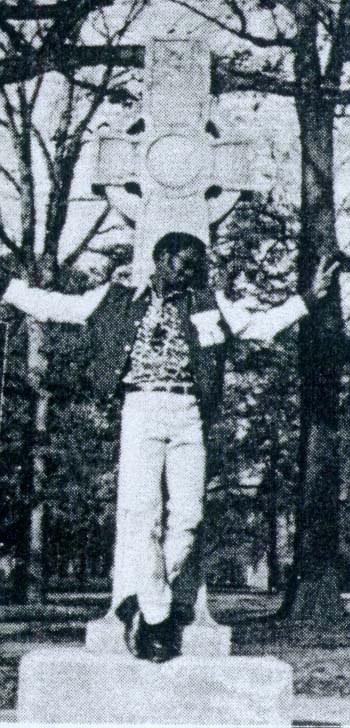|
.jpg) |
||||||
| Pre-Kenyon Life Ulysses Hammond was born in Washington D.C. on February 18, 1951, the oldest son of nine children. His father, Cleveland Hammond., worked as truck driver while his mother, Eliza, was a minister. He and his siblings would often travel along the East coast with his mother, attending Baptist revivals. Hammond attended McKinley High School in Northeast D. C. where he was very active track team and was president of Student government. Ulysses had always hoped to go to college, but did not think that it was financially feasible for him. That was when he met David Spangler, Executive Director of the Woodward Foundation, and a Kenyon Alumni. Spangler thought that Kenyon would be a good match and encouraged him to visit. |
| Ulysses visited in Fall 1968. Kenyon's Black students, Roland Parson, Eugene Peterson, Gary Hayes and Ruben Pope volunteered to pick him up from the airport. Roland Parson and Gary Hayes were also graduates of McKinley High School. Hammond's says that he will never forget that car ride to Kenyon. During the trip, the students told him all about Kenyon, and their experiences as Black men there. Coming from Washington D. C., he was immediate struck by the rural and semi-isolated environment. Hammond knew of Kenyon's academic reputation and received a competitive financial aid package, so he decided to attend Kenyon, entering as a member of the class of 1973. |
| Early Kenyon Life | ||||||
 |
|
|||||
|
|
Hammond entered with 5 other black students including Johnnie Johnson, Barbara Lee, and Doretha Smallwood.
According to Hammond: It was very difficult for Black students, especially those who were introverted...By this time, alcohol and drugs were becoming a solid part of student culture, but not as much of the Black student culture. That's not to say there wasn't experimentation, but we realized that we represented more than just ourselves. To many, we represented all Black people. |
| Organizations/Fraternities and Sports | |
| People always assumed that we were here to play sports; that our role here was to entertain. We weren't recruited
to play sports, but it was how you survived and was an outlet. You survived by staying busy. Hammond played basketball for 2 years and ran track all four. He decided to stop playing basketball during his junior year when he began to seriously consider attending law school. |
|
|
Hammond shown above during a Kenyon basketball game. |
Though he felt socially isolated, Hammond was actively and involved in campus life at Kenyon. In addition to track, in which he lettered four times, Hammond was a resident advisor, Senior Class President, and a founding member of the Black Student Union, in which we would serve as Deputy Chairmen and eventually Chairman during his senior year. Sports proved to be a bittersweet relationship. Like others black students, Hammond recalls very few overtly racist incidents during his time at Kenyon, although there were a few isolated instances. He claims to have experienced more racism while traveling to sporting events than on campus. |
|
Hammond on the Basketball team his freshman year |
|
Race Related Incidents
|
|
|||||
| After leaving Kenyon, Hammond earned his master's degree in public administration and his juris doctorate from Wayne State University Law School. After a career in the Michigan courts system, Hammond became chief executive officer of the District of Columbia Courts. He has also served on the Kenyon College Board of Trustees as an alumni representative. | |||||
|
|
Today, Hammond resides in Concord, Connecticut, where he serves as Vice President for Administration at Connecticut College. He returned to Kenyon several times when on the Board of Trustees, and also returned for the 25th and 30th Anniversary Celebrations for the Black Student Union. | |
|
Hammond Today |
|
|
|
Black Students @ Kenyon in the 1970s |
Kenyon in the 1970s |